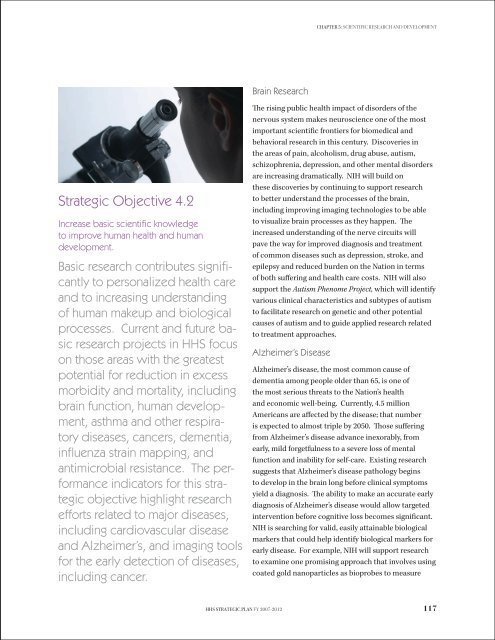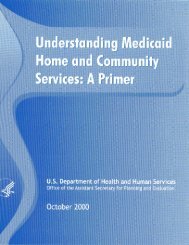STRATEGIC PLAN - ASPE - U.S. Department of Health and Human ...
STRATEGIC PLAN - ASPE - U.S. Department of Health and Human ...
STRATEGIC PLAN - ASPE - U.S. Department of Health and Human ...
You also want an ePaper? Increase the reach of your titles
YUMPU automatically turns print PDFs into web optimized ePapers that Google loves.
CHAPTER 5: Scientific Research <strong>and</strong> DevelopmentBrain ResearchStrategic Objective 4.2Increase basic scientific knowledgeto improve human health <strong>and</strong> hum<strong>and</strong>evelopment.Basic research contributes significantlyto personalized health care<strong>and</strong> to increasing underst<strong>and</strong>ing<strong>of</strong> human makeup <strong>and</strong> biologicalprocesses. Current <strong>and</strong> future basicresearch projects in HHS focuson those areas with the greatestpotential for reduction in excessmorbidity <strong>and</strong> mortality, includingbrain function, human development,asthma <strong>and</strong> other respiratorydiseases, cancers, dementia,influenza strain mapping, <strong>and</strong>antimicrobial resistance. The performanceindicators for this strategicobjective highlight researchefforts related to major diseases,including cardiovascular disease<strong>and</strong> Alzheimer’s, <strong>and</strong> imaging toolsfor the early detection <strong>of</strong> diseases,including cancer.The rising public health impact <strong>of</strong> disorders <strong>of</strong> thenervous system makes neuroscience one <strong>of</strong> the mostimportant scientific frontiers for biomedical <strong>and</strong>behavioral research in this century. Discoveries inthe areas <strong>of</strong> pain, alcoholism, drug abuse, autism,schizophrenia, depression, <strong>and</strong> other mental disordersare increasing dramatically. NIH will build onthese discoveries by continuing to support researchto better underst<strong>and</strong> the processes <strong>of</strong> the brain,including improving imaging technologies to be ableto visualize brain processes as they happen. Theincreased underst<strong>and</strong>ing <strong>of</strong> the nerve circuits willpave the way for improved diagnosis <strong>and</strong> treatment<strong>of</strong> common diseases such as depression, stroke, <strong>and</strong>epilepsy <strong>and</strong> reduced burden on the Nation in terms<strong>of</strong> both suffering <strong>and</strong> health care costs. NIH will alsosupport the Autism Phenome Project, which will identifyvarious clinical characteristics <strong>and</strong> subtypes <strong>of</strong> autismto facilitate research on genetic <strong>and</strong> other potentialcauses <strong>of</strong> autism <strong>and</strong> to guide applied research relatedto treatment approaches.Alzheimer’s DiseaseAlzheimer’s disease, the most common cause <strong>of</strong>dementia among people older than 65, is one <strong>of</strong>the most serious threats to the Nation’s health<strong>and</strong> economic well-being. Currently, 4.5 millionAmericans are affected by the disease; that numberis expected to almost triple by 2050. Those sufferingfrom Alzheimer’s disease advance inexorably, fromearly, mild forgetfulness to a severe loss <strong>of</strong> mentalfunction <strong>and</strong> inability for self-care. Existing researchsuggests that Alzheimer’s disease pathology beginsto develop in the brain long before clinical symptomsyield a diagnosis. The ability to make an accurate earlydiagnosis <strong>of</strong> Alzheimer’s disease would allow targetedintervention before cognitive loss becomes significant.NIH is searching for valid, easily attainable biologicalmarkers that could help identify biological markers forearly disease. For example, NIH will support researchto examine one promising approach that involves usingcoated gold nanoparticles as bioprobes to measureHHS Strategic Plan FY 2007-2012117
















